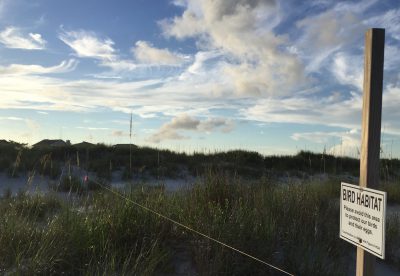FIGURE EIGHT ISLAND – David Morrisette leans over the white porch railing of his family’s home overlooking acres of unspoiled beach at the north end of this exclusive island.
“Look at it. It’s incredible,” he says.
Supporter Spotlight
Somewhere in the distance, his children and wife are enjoying their last evening on the white sands of Figure Eight Island before heading back to their home in the mountains of Virginia.
As much as he’d hate to walk away, not so much for his sake, he says, as for that of his wife and children, Morrisette has made up his mind that’s exactly what he will do if a terminal groin is built on the island’s northern end. A terminal groin is a wall-like structure made of rock or other material placed perpendicular to the shore adjacent to an inlet to control erosion.

He and his siblings, all of whom share ownership of the house, do not support the proposed project and they’re in a unique position that could stop the project in its tracks.
“I’ll sell my part of the house,” Morrisette said. “I’m not going to keep a house here with this kind of garbage going on. I’m not going to bear the cost of this thing. There’s absolutely no need for it.”
The Figure Eight homeowners’ association’s board of directors is awaiting approval of a federal permit to build a 1,500-foot-long rock groin across the tip of island’s north end. The permit application was filed in late June after the Army Corps of Engineers released a final environmental study on the proposed project. The public had until Aug. 1 to submit comments about the project to the Corps.
Supporter Spotlight
The homeowners’ board estimates the project will cost $7.3 million for initial construction and beach fill costs with costs of $23 million for maintenance and necessary beach fill over a 30-year period. However, an official study conducted by the state estimates that over that same timeframe a groin like the one proposed for Figure Eight can cost upwards of $50 million.
Figure Eight is unincorporated, and the homeowners’ association doesn’t have the legal authority to condemn property. Without easements from property owners, the project, in its proposed location, can’t move forward.
The board will need anywhere from 12 to 15 property easements, including a portion of land Morrisette and his siblings own. They’re not budging, he said, and, according to him, neither are some of his neighbors.
“From what I understand there’s a lot more people against it than for it,” Morrisette said.
Sand has for years steadily accreted at the north end, creating what is now nearly 60 acres of natural vegetation, wetlands and beach at Rich Inlet in New Hanover County.
Morrisette wholeheartedly believes the pristine earth that Mother Nature has built up at the north end will erode away and that Rich Inlet, one of the few remaining natural inlets in the state, will forever change if a terminal groin is built.
Environmental groups, including the North Carolina Coastal Federation, which formed the “Save Rich Inlet” campaign two years ago, point out that the project’s own environmental study indicates land north of the terminal groin will eventually erode.
The loss would affect thousands of shorebirds, including federally endangered piping plovers and red knots, which nest, rest and forage at Rich Inlet.

In the 30 years since his father bought the house, Morrisette has witnessed the land grow, putting more distance between the home and the Atlantic Ocean. When the house came under the ownership of the Morrisettes, ocean waves at high tide licked the steps at the base of a short, wooden walkway leading to the house. Now, it’s easily a 10-minute walk from those steps to the beach.
White stakes, one roughly 60 yards from the Morrisette’s back door, mark the location of the proposed terminal groin.
The light-gray colored home with bright white trim sits between a well-manicured front lawn with lush, green bushes and trees and a backyard view of the uninhabited Hutaff and Lea Islands and Topsail Island to the north and Wrightsville Beach to the south.
Figure Eight Island was like no other place William Morrisette had seen on the North Carolina coast, his son says. Its beaches were not cluttered with sunbathers. There were no high-rises. No commercial development.
William Morrisette offered half of the asking price on the house after his first visit to the island. The sellers accepted.
“He said this is the greatest manipulation his children have ever pulled off,” David Morrisette recalls. “We gambled. The ocean was practically at the back door. We took a chance and we won.”
He and his siblings rotate their summer getaways and holidays at the home.
The three-story, 6,000-square-foot, six-bedroom home is an unassuming dwelling in comparison to the sprawling mansions on the southern end of the island.
A series of navy- and white-striped beach towels, individually monogrammed with the names of each of his 10 children, hangs uniformly over the front porch railing of the house.
They plan to come back for a couple of weeks in September, one last pre-autumn beach break from their rural countryside home where Morrisette runs Chateau Morrisette Winery, one of the largest wineries in Virginia.
“I wonder, is my house going to be devalued because of this?” Morrisette says as he looks across the back of the property. “That’s the least of my concerns. I love the beach, but it’s much more for my family. I want them to be able to have this memory growing up. You can see just how natural this is. Why are we messing with nature?”







